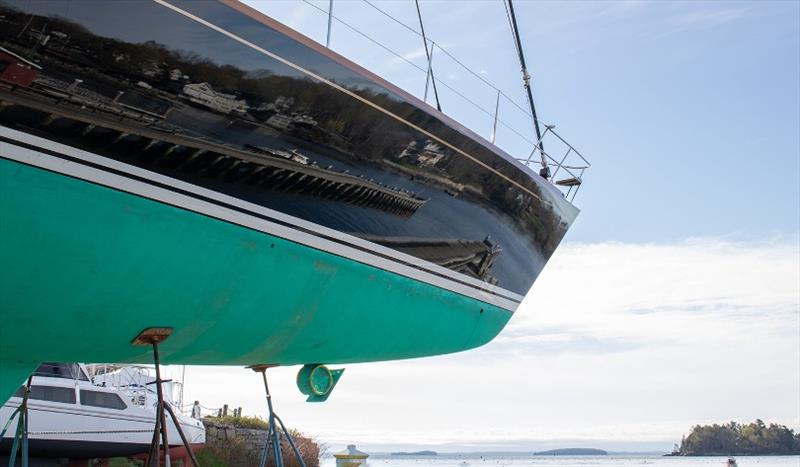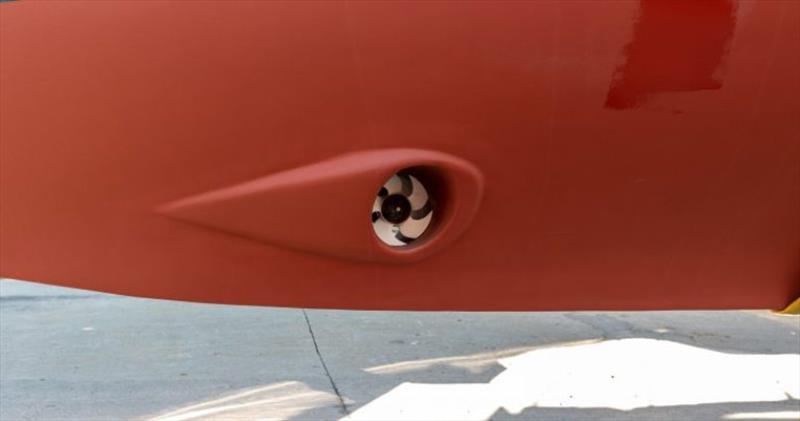
Do you or don't you need a bow thruster?
by Lyman-Morse Boatbuilding 1 Apr 2020 23:00 PDT

Bow Thrusters © Lyman-Morse Boatbuilding

Bow Thrusters ©Lyman-Morse Boatbuilding
previous next - 1
- 2
- 3
- 4
- 5
- 6
- 7
Bow thrusters, like politics, drive intense debate. Some boat owners argue that a lateral port or starboard nudge is indispensable when docking.
Others contend that a thruster's complexities of cut-out tunnels, drop-down props, batteries and cables are unneeded drag, weight, and cost. Some believe that good design and boat handling skills should eliminate the need for a bow thruster.
Still, bow and the larger family of maneuvering thrusters are undeniably popular: Roughly 50 percent of all 30- to 65-foot recreational yachts feature a bow thruster, according to Southern Boating Magazine. Factor in sophisticated transverse propulsion systems on larger vessels and low-cost externally mounted thrusters found on smaller boats, and the bow thruster market certainly gets far larger.
Not surprisingly, Lyman-Morse has designed and installed countless maneuvering thruster systems. But interestingly, of the several hundred power and sail boats we service annually or have built, perhaps 3 out of 10 feature the technology. In fact, on our newly announced LM46 Performance Cruiser, a bow thruster is an option; but not a recommended one. The LM46 program is in the school of good design, and good boat handling, means there is no need.
On the currently in-construction Hood 57, bow thrusters were essentially rendered obsolete: The vessel features twin, counter-rotating propellers and individually steerable propulsion modules, as part of the Volvo Penta IPS1350 Pod drive technology. The boat pivots with a touch of a joystick.
Picnic boat pairing
But, on over 1,200 JetStick-controlled Hinckley Picnic Boats, bow thrusters play a critical role. "When we first introduced those boats, it was very difficult to harness the jet drive's authority at low speed. You never knew where neutral was," says Shepard "Shep" McKenney, the serial marine entrepreneur who led the team that developed the JetStick technology for Hinckley in the mid 1990s. "But once we installed a bow thruster, we gained infinite fingertip control over the jets, and we never sold a boat without one."
To better explore the decision-making process in choosing a thruster, we dug into last year's retrofit of the sister-ship of the record-breaking round-the-world racer British Steel: the 1985 Robert Clarke-designed, 60-foot steel ketch Gone with the Wind.
"This was an experienced owner, who had circumnavigated before, who was taking his wife and two young kids on another round-the-world cruise," says Philipp Schietinger, carpentry foreman at the Lyman-Morse boatyard in Camden, Maine, who supervised the project.
"He knew exactly what he was looking for: A thruster to handle a 65,000-pound boat when docking in less than ideal conditions."
Thrusters engaged
Positional thrusters first appeared on commercial ships in the mid-20th century as low-cost alternatives to hiring pricey tugboats to maneuver in crowded ports. But starting in the mid-1980s, marine equipment makers like Side-Power, ABT TRAC, Lewmar, Vetus, Yacht Thruster, Sideshift and Thrustmaster flooded the market, as they realized bow thrusters were the salve for boat owners' biggest fear: Docking.
For Gone with the Wind, that meant Schietinger and the design team at Lyman-Morse began to work through the myriad of bow thruster options. A simple externally mounted thruster was rejected as too feeble. Also dismissed as too complex were emerging water jets, electric rim thrusters, and combination tunnel/drop-down thrusters. A retractable drop-down and a hydraulically powered unit were also avoided as too costly and complicated for a world-circling family cruiser.
Instead, a conventional battery driven, 24-volt, Side-Power SE170 tunnel thruster, mounted through the boat's bow inside a roughly 10-inch steel tube, proved to be the right mix of low-cost, easy maintenance, and durability.
Ed Joy, one of Lyman-Morse's marine architects, then weighed in on the critical position of the thruster's tunnel. "There are three factors," says Joy, "Distance forward of the boat's pivot axis, distance below the waterline, and length of the installed tube."
Balance of power
Joy balanced these factors against the center of the boat's windage — or 'lateral wind draft area' — to find the thruster position that maximized its turning moment. Gone With The Wind's thruster was placed just aft enough of the bow to allow for a 12-inch tunnel depth. That single tube diameter depth prevents air or sea foam from getting ingested into the unit.
The thruster's batteries were then carefully sequestered from the main house electrics; they were located close to the drive unit to minimize lost voltage from long wire runs.
Once planned, the welding team from Lyman-Morse Fabrication carefully cut the tunnel duct holes and mounted the 10-inch steel tube through the bow. Then Scheitinger beveled and faired the welding work to the form of the hull to mitigate drag.
Who then wins the thruster debate? That all depends: "I'd personally have one," says Kevin Dibley, owner of Dibley Marine Design based in Queenstown, New Zealand, and the designer of the LM46.
"Some of my current clients wouldn't. It's all choice."